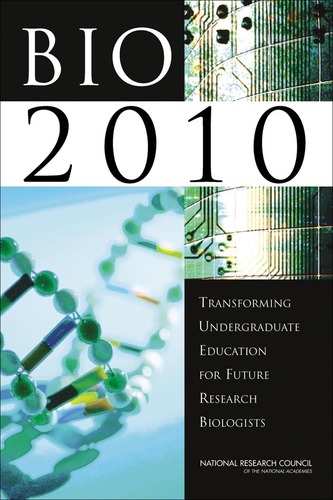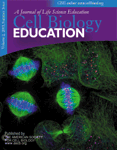Fueling Educational Reform: Bio2010—Biology for the Future
Last fall the National Research Council released a report (Figure 1 shows the report's cover) calling for changes in undergraduate biology education. The report, Bio2010: Transforming Undergraduate Education for Future Research Biologists, is the product of an 18-month study by a committee of 11 eminent scientists (see list on p. 86). It examines ways to integrate mathematics and physical and information sciences into the education of undergraduate biology students. The study's sponsors, the National Institutes of Health and the Howard Hughes Medical Institute, asked the committee to focus on students who intend to become researchers, especially in the biomedical sciences. The report concludes that significant advances in biological knowledge could result if interdisciplinary thinking and work become second nature to researchers and that connections between biology and the other scientific disciplines need to be developed and reinforced at the undergraduate level for this to happen.
The suggested changes in undergraduate education are based on how biologists now design, perform, and analyze experiments as well as the increasing reliance on quantitative models, concepts, and methods drawn from other scientific disciplines. The report suggests ways to incorporate interdisciplinary ideas and lists concepts from other scientific fields most relevant to biology. The resources highlighted in the report can be used in diverse ways. For example, a physics professor seeking to illuminate some of the connections between physics and biology could choose to include the workings of microscopes in the curriculum or to discuss ways scientists from different disciplines conceptualize energy. Faculty could develop modules based around the report's suggested topics of epidemics or the topology of DNA or choose to adapt or adopt existing modules like Carbohydrates in Organic Chemistry.1 Alternatively faculty could design a new course or adapt an existing one, such as the freshman seminar designed at the University of Oregon to expose students to Plagues: The Past, Present and Future of Infectious Diseases.2
1This module is described in Case Study 3 and is now a part of the ChemConnections collection at http://mc2.cchem.berkeley.edu/. A list of quantitative modules for biology can be found at the University of Tennessee site, http://www.tiem.utk.edu/~gross/bioed/modulelist.html, home to the course Mathematics for the Life Sciences (Case Study 4) designed to replace the traditional year of calculus for biology majors.
2This course is described in Case Study 11. The seminar linked scientific (immunology, evolution), social, and ethical issues. A syllabus is posted at http://biology.uoregon.edu/Biology_www/Online_classes/Bi199w97u/syllabus.html.
Increasing the interdisciplinary focus of undergraduate education is not enough on its own to prepare students for biological research. The committee calls for making special efforts to communicate the excitement of today's biological research. For example, the report suggests modeling laboratory courses on modern research topics because real experiments combine elements from different disciplines. To build on this idea, the report encourages independent research as early as is practical in undergraduate education, with credit given to both students and their advisors. Another way to increase exposure to cutting-edge developments in biological research is through seminar-type courses that can combine discussions with faculty or other researchers with student research projects. The committee feels that departments should make an effort to make these types of courses available on a regular basis throughout the 4-year undergraduate education of students.
The readers of Cell Biology Education are a well-informed group, and not all of the material in the report will be new to them. Readers who are already familiar with the ideas of reform could use the report as a persuasive tool to draw in faculty or administrators who are not as focused on education. For example, the concept lists within the report could be used to spark debate during a faculty meeting. Biology faculty could discuss what kinds of interdisciplinary education might be useful to the students at their institution. They could later meet with faculty in chemistry, mathematics, or physical sciences to talk about what is now covered and what kinds of changes might be feasible or desirable. Such discussions could be used as starting points to encourage collaborative work on ways to integrate mathematics and physical sciences into life science courses as well as avenues for incorporating life science examples into courses taught in mathematics and physical sciences.
In its chapter on implementation, the committee calls for concerted action by faculty, administrators, professional societies, and other educational organizations, foundations, industry, and government to help faculty increase interdisciplinary learning by facilitating the development of new materials and approaches. Faculty development is a crucial component to improving undergraduate biology education and requires action both on individual campuses and nationally to provide faculty the time necessary to refine their own understanding of how the integrative relationships of biology, mathematics, and the physical sciences can best be melded into new or existing courses. Biology education could benefit if faculty from different backgrounds were able to work together to develop courses, modules (on biological problems suitable for study in mathematics and physical science courses, and vice versa), and other teaching materials. University administrators must provide support for this to be a real possibility, for example by decreasing cross-departmental barriers to collaboration. Faculty must be provided with the necessary time, encouragement, and resources to develop new approaches and to assess how well they help students to meet the desired learning goals.
Figure 1. Cover of the National Research Council's report, Bio2010.
At the local level the committee urges each academic institution to critically review how it educates its future biologists by considering current educational objectives, practices, and outcomes. One potential setting for this activity is a departmental retreat, which can help to identify desired changes, consider the resources needed to implement the changes, and define action plans for moving toward those goals in a setting designed for creative thinking. Inviting faculty from another department on campus to participate can broaden the circle and provide fresh perspective. One of the Bio2010 committee members has expanded this activity beyond his own campus. James Gentile held a retreat for faculty from his Division of Natural Sciences at Hope College in Holland, Michigan, and colleagues from Harvey Mudd College in Claremont, California. He and Sheldon Wettack of Harvey Mudd challenged the faculty to design the scientific components of a college from scratch in order to allow them to imagine the possibilities free from existing constraints.
On a national level the committee recommends the creation of an annual Summer Institute on undergraduate biology education as an effective way to foster educational innovation, support faculty, and facilitate the creation of ideas for new modules, books, laboratory guides, and other materials. A pilot workshop is scheduled for this August (2003) at the University of Wisconsin, Madison.
The committee believes that most biology students would benefit from increased interdisciplinary education and that institutions of all types can move in that direction. They recognize that not all institutions will use the same mechanisms to achieve these goals. The implementation of new approaches should be accompanied by a parallel process of assessment to consider the ramifications of any changes and to verify that progress is being made toward the institutional goal of student learning. Bio2010 presents numerous ideas in the belief that each institution will identify for itself the most relevant options. If you would like to learn the full scope of those ideas, the full text of the report can be read for free online or a hard copy of the report can be purchased at http://www.nap.edu/catalog/10497.html.
FOOTNOTES
Membership of the Bio2010 Committee
Lubert Stryer (Chair), Stanford University, Stanford, California
Ronald Breslow, Columbia University, New York, New York
James Gentile, Hope College, Holland, Michigan
David Hillis, University of Texas, Austin, Texas
John Hopfield, Princeton University, Princeton, New Jersey
Nancy Kopell, Boston University, Boston, Massachusetts
Sharon Long, Stanford University, Stanford, California
Edward Penhoet, Gordon and Betty Moore Foundation, San Francisco, California
Joan Steitz, Yale University, New Haven, Connecticut
Charles Stevens, The Salk Institute for Biological Studies, La Jolla, California
Samuel Ward, University of Arizona, Tucson, Arizona



